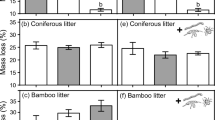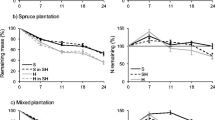Abstract
Tree species influence the litter decomposition process by influencing litter quality and soil microclimate. Furthermore, over the long term, trees could promote soil communities that are particularly capable of degrading the litter they encounter most often. Thus, plant litter could decompose faster when placed in the habitat from which it was derived than in a foreign habitat, which has been termed home field advantage (HFA) of litter decomposition. In mixed-plant species environments however, it is not known whether a specific decomposer community under one tree species is affected by the presence of another tree species in the vicinity. To address this question, we tested if spruce and poplar litters showed HFA in mono-specific and in mixed species plantations under each tree species by reciprocally transplanting litter in the two plantation types. Decomposition rates, as well as the composition and ability of decomposer communities to degrade the different types of litter, were monitored during two years. Only spruce litter exhibited a faster decomposition rate at home. This HFA could be explained by higher abundance of decomposers. Furthermore, cellulose and poplar litter decomposed less or similarly in spruce plantations, suggesting that soil communities of that environment were capable of specifically degrading spruce litter. In mixed plantations, HFA was in the same direction as in mono-specific plantations, but was not as strong, indicating that HFA is sensitive to the surrounding plant community. Furthermore, this “mixed environment” had synergistic effects on decomposition rates under poplar trees. These ‘tree environment-specific’ results highlighted the possible importance of spatial distribution of each litter on decomposition rates in mixed stands. Thus, the influence of litter dispersal should be taken into account in future studies.






Similar content being viewed by others
References
Aubert M, Margerie P, Ernoult A, Decaens T, Bureau F. 2006. Variability and heterogeneity of humus forms at stand level: comparison between pure beech and mixed beech-hornbeam forest. Ann For Sci 63:177–88.
Ayres E, Dromph KM, Bardgett RD. 2006. Do plant species encourage soil biota that specialise in the rapid decomposition of their litter? Soil Biol Biochem 38:183–6.
Ayres E, Steltzer H, Berg S, Wall DH. 2009a. Soil biota accelerate decomposition in high-elevation forests by specializing in the breakdown of litter produced by the plant species above them. J Ecol 97:901–12.
Ayres E, Steltzer H, Simmons BL, Simpson RT, Steinweg JM, Wallenstein MD, Mellor N, Parton WJ, Moore JC, Wall DH. 2009b. Home-field advantage accelerates leaf litter decomposition in forests. Soil Biol Biochem 41:606–10.
Ball BA, Hunter MD, Kominoski JS, Swan CM, Bradford MA. 2008. Consequences of non-random species loss for decomposition dynamics: experimental evidence for additive and non-additive effects. J Ecol 96:303–13.
Berger TW, Berger P. 2014. Does mixing of beech (Fagus sylvatica) and spruce (Picea abies) litter hasten decomposition? Plant Soil 377:217–34.
Berlese A. 1905. Apparicchio per raccogliere presto ed in gran numero di piccoli artropodi. Redia 2:85–9.
Bray JR, Curtis JT. 1957. An ordination of the upland forest communities of Southern Wisconsin. Ecol Monogr 27:325–49.
Chapman SK, Koch GW. 2007. What type of diversity yields synergy during mixed litter decomposition in a natural forest ecosystem? Plant Soil 299:153–62.
Chomel M, DesRochers A, Baldy V, Larchevêque M, Gauquelin T. 2014. Non-additive effects of mixing hybrid poplar and white spruce on aboveground and soil carbon storage in boreal plantations. For Ecol Manag 328:292–9.
Coineau Y. 1974. Introduction à l’étude des microarthropodes du sol et ses annexes. p 118.
Cornwell WK, Cornelissen JHC, Amatangelo K, Dorrepaal E, Eviner VT, Godoy O, Hobbie SE, Hoorens B, Kurokawa H, Perez-Harguindeguy N, Quested HM, Santiago LS, Wardle DA, Wright IJ, Aerts R, Allison SD, van Bodegom P, Brovkin V, Chatain A, Callaghan TV, Diaz S, Garnier E, Gurvich DE, Kazakou E, Klein JA, Read J, Reich PB, Soudzilovskaia NA, Vaieretti MV, Westoby M. 2008. Plant species traits are the predominant control on litter decomposition rates within biomes worldwide. Ecol Lett 11:1065–71.
Crowther TW, Boddy L, Jones TH. 2011. Species-specific effects of soil fauna on fungal foraging and decomposition. Oecologia 167:535–45.
De Deyn GB, van der Putten WH. 2005. Linking aboveground and belowground diversity. Trends Ecol Evol 20:625–33.
Ettema CH, Wardle DA. 2002. Spatial soil ecology. Trends Ecol Evol 17:177–83.
Garland JL, Mills AL. 1991. Classification and characterization of heterotrophic microbial communities on the basis of patterns of community-level sole-carbon-source utilization. Appl Environ Microbiol 57:2351–9.
Gartner TB, Cardon ZG. 2004. Decomposition dynamics in mixed-species leaf litter. Oikos 104:230–46.
Gessner MO, Chauvet E. 1993. Ergosterol-to-biomass conversion factors for aquatic hyphomycetes. Appl Environ Microbiol 59:502–7.
Gessner MO, Schmitt AL. 1996. Use of solid-phase extraction to determine ergosterol concentrations in plant tissue colonized by fungi. Appl Environ Microbiol 62:415–19.
Gholz HL, Wedin DA, Smitherman SM, Harmon ME, Parton WJ. 2000. Long-term dynamics of pine and hardwood litter in contrasting environments: toward a global model of decomposition. Global Change Biol 6:751–65.
Gisin H. 1960. Collembolen fauna Europas. Genève: Museum d’Histoire naturelle.
Hansen RA. 2000. Effects of habitat complexity and composition on a diverse litter microarthropod assemblage. Ecology 81:1120–32.
Hättenschwiler S, Tiunov A, Scheu S. 2005. Biodiversity and litter decomposition in terrestrial ecosystems. Annu Rev Ecol Evol Syst 36:191–218.
Hobbie SE, Reich PB, Oleksyn J, Ogdahl M, Zytkowiak R, Hale C, Karolewski P. 2006. Tree species effects on decomposition and forest floor dynamics in a common garden. Ecology 87:2288–97.
Hunt HW, Ingham ER, Coleman DC, Elliott ET, Reid CPP. 1988. Nitrogen limitation of production and decomposition in prairie, montain meadow, and pine forest. Ecology 69:1009–16.
Keiser AD, Keiser DA, Strickland MS, Bradford MA. 2014. Disentangling the mechanisms underlying functional differences among decomposer communities. J Ecol 102:603–9.
Keiser AD, Knoepp JD, Bradford MA. 2013. Microbial communities may modify how litter quality affects potential decomposition rates as tree species migrate. Plant Soil 372:167–76.
McTiernan KB, Ineson P, Coward PA. 1997. Respiration and nutrient release from tree leaf litter mixtures. Oikos 78:527–38.
Meidute S, Demoling F, Baath E. 2008. Antagonistic and synergistic effects of fungal and bacterial growth in soil after adding different carbon and nitrogen sources. Soil Biol Biochem 40:2334–43.
Oksanen J, Blanchet GF, Kindt R, Legendre P, Minchin PR, O’Hara B. 2012. Vegan: Community Ecology Package. R version 2.0-3. Available at: http://vegan.r-forge.r-project.org/.
Olson JS. 1963. Energy storage and balance of producers and decomposers in ecological systems. Ecology 44:322–31.
Paterson E, Osler G, Dawson LA, Gebbing T, Sim A, Ord B. 2008. Labile and recalcitrant plant fractions are utilised by distinct microbial communities in soil: independent of the presence of roots and mycorrhizal fungi. Soil Biol Biochem 40:1103–13.
Perez-Harguindeguy N, Diaz S, Cornelissen JHC, Vendramini F, Cabido M, Castellanos A. 2000. Chemistry and toughness predict leaf litter decomposition rates over a wide spectrum of functional types and taxa in central Argentina. Plant Soil 218:21–30.
Pinheiro J, Bates D, DebRoy S, Sarkar D, the R Core team. 2014. nlme: Linear and Nonlinear Mixed Effects Models. R package version 3.1-115, http://CRAN.R-project.org/package=nlme.
Prescott CE, Grayston SJ. 2013. Tree species influence on microbial communities in litter and soil: Current knowledge and research needs. For Ecol Manag 309:19–27.
Preston-Mafham J, Boddy L, Randerson PF. 2002. Analysis of microbial community functional diversity using sole-carbon-source utilisation profiles—a critique. FEMS Microbiol Ecol 42:1–14.
Ruzicka S, Edgerton D, Norman M, Hill T. 2000. The utility of ergosterol as a bioindicator of fungi in temperate soils. Soil Biol Biochem 32:989–1005.
Saetre P, Baath E. 2000. Spatial variation and patterns of soil microbial community structure in a mixed spruce-birch stand. Soil Biol Biochem 32:909–17.
Saetre P, Brandtberg PO, Lundkvist H, Bengtsson J. 1999. Soil organisms and carbon, nitrogen and phosphorus mineralisation in Norway spruce and mixed Norway spruce-birch stands. Biol Fertil Soils 28:382–8.
Scheu S. 2002. The soil food web: structure and perspectives. Eur J Soil Biol 38:11–20.
Schneider K, Renker C, Maraun M. 2005. Oribatid mite (Acari, Oribatida) feeding on ectomycorrhizal fungi. Mycorrhiza 16:67–72.
Strickland MS, Osburn E, Lauber C, Fierer N, Bradford MA. 2009. Litter quality is in the eye of the beholder: initial decomposition rates as a function of inoculum characteristics. Funct Ecol 23:627–36.
Swift MJ, Heal OW, Anderson JM. 1979. Decomposition in terrestrial ecosystems. Oxford: Blackwell Scientific. p 509.
Veen GF, Freschet GT, Ordonez A, Wardle DA. 2015. Litter quality and environmental controls of home-field advantage effects on litter decomposition. Oikos 124:187–95.
Vivanco L, Austin AT. 2008. Tree species identity alters forest litter decomposition through long-term plant and soil interactions in Patagonia, Argentina. J Ecol 96:727–36.
Wallenstein MD, Haddix ML, Ayres E, Steltzer H, Magrini-Bair KA, Paul EA. 2013. Litter chemistry changes more rapidly when decomposed at home but converges during decomposition-transformation. Soil Biol Biochem 57:311–19.
Wang QK, Wang SL, Huang Y. 2009. Leaf litter decomposition in the pure and mixed plantations of Cunninghamia lanceolata and Michelia macclurei in subtropical China. Biol Fertil Soils 45:371–7.
Wang QK, Zhong MC, He TX. 2013. Home-field advantage of litter decomposition and nitrogen release in forest ecosystems. Biol Fertil Soils 49:427–34.
Wardle DA. 2002. Communities and ecosystems: linking the aboveground and belowground components. Princeton: Princeton University Press.
Wardle DA. 2006. The influence of biotic interactions on soil biodiversity. Ecol Lett 9:870–86.
Wardle DA, Bonner KI, Nicholson KS. 1997. Biodiversity and plant litter: Experimental evidence which does not support the view that enhanced species richness improves ecosystem function. Oikos 79:247–58.
Wardle DA, van der Putten WH. 2002. Biodiversity, ecosystem functioning and above-ground-below-ground linkages. In: Loreau M, Naeem S, Inchausti P, Eds. Biodiversity and ecosystem functioning: synthesis and perspectives. New York: Oxford University Press. p 155–68.
Acknowledgments
We thank Line Blackburn for field assistance, Caroline Lecareux and Germain Bougnou for chemical analyses, and W.F.J. Parsons for English language correction and for his comments on the manuscript. This study was supported by the Natural Sciences and Engineering Research Council of Canada (NSERC-CRSNG) through a Collaborative and Research Development grant awarded to Annie DesRochers. We also thank the CRSNG-UQAT-UQAM Industrial Chair in Sustainable Forest Management, the Quebec Intensive Silviculture Network and the CEF for additional support. Finally, we thank two excellent reviewers for their critical comments for the improvement of this manuscript.
Author information
Authors and Affiliations
Corresponding author
Additional information
Author contributions
AD, MGL and VB were leaders of the project. All authors participated to the design of the study. MC performed the present study and analyzed the data. All authors contributed to the writing of the present manuscript.
Electronic supplementary material
Below is the link to the electronic supplementary material.
Rights and permissions
About this article
Cite this article
Chomel, M., Guittonny-Larchevêque, M., DesRochers, A. et al. Home Field Advantage of Litter Decomposition in Pure and Mixed Plantations Under Boreal Climate. Ecosystems 18, 1014–1028 (2015). https://doi.org/10.1007/s10021-015-9880-y
Received:
Accepted:
Published:
Issue Date:
DOI: https://doi.org/10.1007/s10021-015-9880-y




